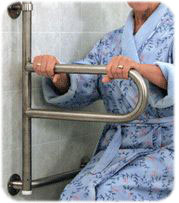It has been proven time and time again, that the elderly and physically challenged retain their independence longer if they are assisted with handrails and grab bars throughout their homes.
The most common reason for installing handrails is to prevent accidents from occurring. When exiting or entering the shower and tub, there is a risk of slippery floors or falling when nothing is there to grab onto except the smooth wall. A safety bar affixed to the wall can help stabilize a person and will prevent falling. A walk through a long hallway can seem daunting without handrails. Install and use hallway assist handrails all along the walls.
Toilet Handrails
 Additionally, hand rails placed beside the toilet will assist the individual in arising back up into a standing position after sitting down on the toilet. A good tip to remember is before installing handrails in the home, it is advisable to read all the requirements from the ADA (Americans with Disabilities Act) for safety and measurement specifications. Whether they are toilet handrails or shower grab bars, they should follow the ADA recommendations.
Additionally, hand rails placed beside the toilet will assist the individual in arising back up into a standing position after sitting down on the toilet. A good tip to remember is before installing handrails in the home, it is advisable to read all the requirements from the ADA (Americans with Disabilities Act) for safety and measurement specifications. Whether they are toilet handrails or shower grab bars, they should follow the ADA recommendations.
ADA Handrails Recommendations
For example, grab bars for the shower/tub must be installed in the correct position, be in 1 to 1 1/2 inches in diameter, constructed of 18 gauge stainless steel and meet the standards the ADA sets forth. Grab bars or handrails for the toilet are of the same stainless steel strength and measurements, with the exception that these can be 1 1/4 to 1 inch in tubular size.
Cost of Horizontal Handrails
Hallway Handrails
The cost of handrails for the interior or exterior of the home is not paid by Medicare in many instances. Handrails are considered personal convenience items and will not be covered by Medicare. If it is a medical necessity as documented by the doctor, then there is a small chance it will be covered and reimbursed by a private insurance. However, the cost of handicap handrails is relatively inexpensive compared to the benefits that they provide. For those individuals who must pay out of pocket, shower grab bars or handrails for the shower (like the image to the right) cost around $10 to $20 per rail.
- Buy Affordable Handicap Handrails – Place these hallway grab bars where you have to walk a long distance and will need the extra support.
Flip Up Handrails
 Another type of handrail for the physically challenged is the wall mounted flip up grab bars or rail. This particular handrail is installed securely on one side of the toilet, and may easily be lifted back up against the wall when not in use. The prices are very reasonable for the assistance they provide. If desired, two grab bar flip rails may be affixed instead of a single rail, and both will support you when you need to get up off a toilet.
Another type of handrail for the physically challenged is the wall mounted flip up grab bars or rail. This particular handrail is installed securely on one side of the toilet, and may easily be lifted back up against the wall when not in use. The prices are very reasonable for the assistance they provide. If desired, two grab bar flip rails may be affixed instead of a single rail, and both will support you when you need to get up off a toilet.
Assist bars are another name for the type of handrails that installed along hallways or throughout the entire home. They will provide a sense of security and increased independence and functioning.
Maintenance of Handrails
The maintenance is simple and inexpensive, and consists of tightening loose handrails as needed and sanitizing them once weekly with a good anti bacterial water or alcohol based cleaner. White vinegar works well too for those sensitive to stronger products. It is important to never use a lubricant on handrails as it may cause the bar to become unsafe and contribute to accidental slipping or a bad fall.


Comments are closed.